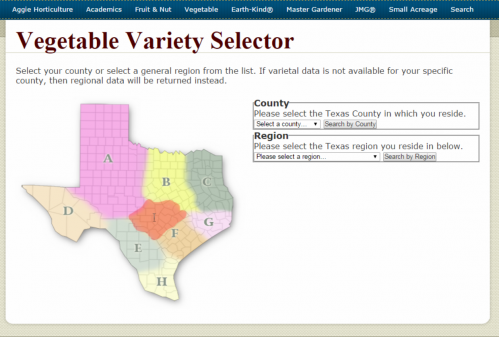Picking vegetables to grow starts with knowing where to plant

No matter how you look at it, the online Texas Vegetable Variety Selector will help growers choose the best types to grow in a particular locale, according to Dr. Joe Masabni, Texas A&M AgriLife Extension Service horticulturist in College Station.
"It's a one-stop website designed to help AgriLife Extension agents and the people they serve throughout the state," said Masabni, the site's creator. "I collected the variety recommendations from all the counties and updated them with the currently available varieties."
At the site, aggie-horticulture.tamu.edu/pu … cations/veg_variety/, a viewer can start with either a county or region. An interactive map helps the user determine how to select alocation.
If a specific county is selected, Masabni explained, the user then can either select a specific vegetable or request a list of all vegetables for that county. The resultant list will provide several possibilities and the number of days required from planting to harvest.
If "all vegetables" is selected, the list will yield categories of vegetables with several possible varieties for each and the number of growing days before harvest in the specific county, he added.
In some cases, a grower might want to view vegetable varieties that are good for a region, Masabni said.
"I designed the map to include a region primarily because some counties are in transition between two climatic zones, which makes it hard to determine which variety list to choose," he said. "By choosing a region, one may get a more accurate list of vegetables rather than trying to guess which zone fits a location better."
When selecting a region, the user can also narrow the list by specific vegetable or get a list of all vegetables with the varieties best suited for that area, Masabni said.
"Some crops and varieties can be grown in many regions of Texas. Other crops, such as onions, and some varieties, such as Celebrity tomato, are more adapted to particular regions than others," Masabni said. "Choosing the right variety is a big step for a grower – whether commercial or at home – to have a successful crop."
The database contains information for more than 240 counties and eight regions, he said. In all, more than 40 vegetables and 200 varieties are listed for possibly growing in the state.
At this point, there isn't information for Far West Texas, Masabni said, though he is working to determine varieties for that region and will add them soon.
"The list of varieties comes from two sources – from results of research conducted by AgriLife Extension specialists and county agents and from demonstration trials," he added. "Some varieties that are not on the list may have worked well for a gardening enthusiast but are not on our list, pending research-based trials."
Provided by Texas A&M University



















